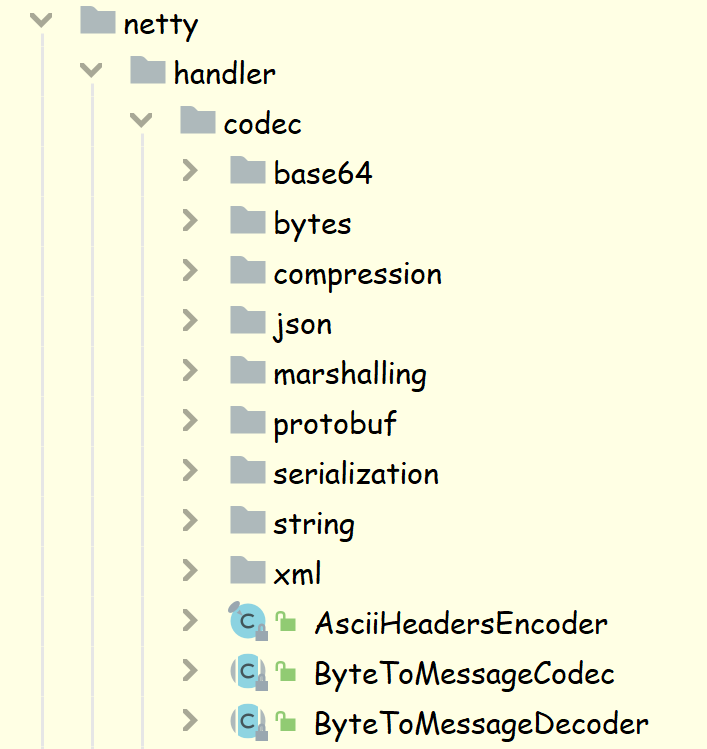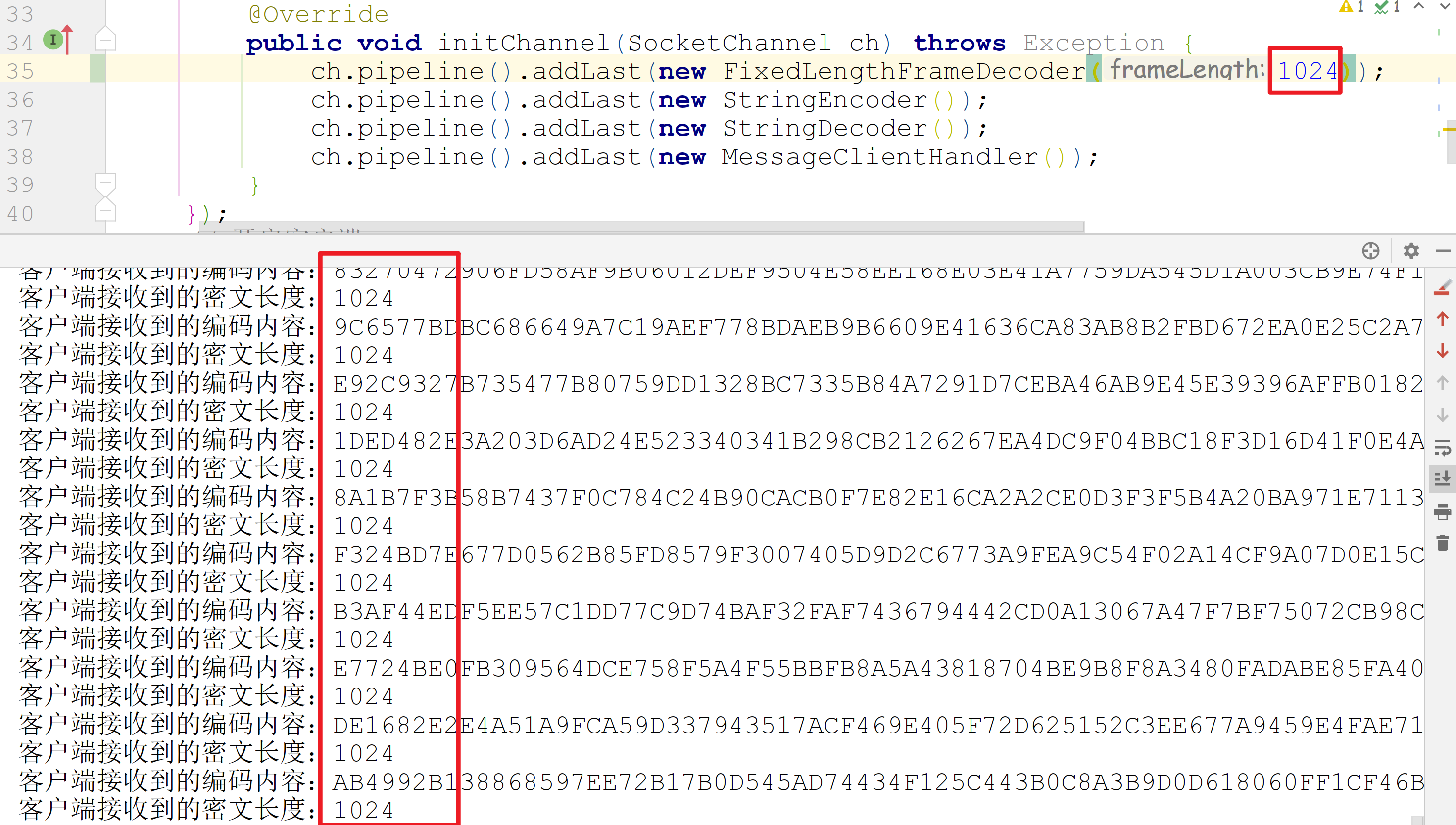1、半包粘包
例如发送两个数据包给服务器,由于服务端一次读取到的字节数不一定的分
没有半包和拆包:服务器分两次读取到两个地理的数据包,这个情况没有拆包和粘包的情况
- 粘包:服务器一次收到两个数据包,在一起收到的
- 拆包:第一次读取到完成的第一个包和第二个包的一部分内容,第二次读取到第二个包的剩余内容
- 整包:第一次读取到第一包的部分内容,第二次读取到第一个包的剩余部分和第二个包的全部
- 多次拆包:如果接收滑窗非常小,数据量大的时候发生多次发送的接收的情况
为什么会出现半包和粘包
Netty粘包和拆包的问题,本质上归结于TCP的粘包和拆包。 :::info 网络上发送一个完整的数据包时,可能会被TCP拆分成多个包进行发送,也可能把多个小的包封装成一个大的数据包发送,这就是所谓的TCP的粘包和拆包问题 ::: 1、HTTP 中有一个 Nagle 算法,每个报文都是一段的,使用网络发送发现网络效率低,然后 HTTP 设置一个算法,设置到一定程度发,所以出现一些延时,提高销量,所以形成了粘包
2、HTTP缓冲区引起的,报文段大的时候的时候直接弄在一起发送过去。怎么解决
不断的从 TCP 的缓冲区中读取数据,每次读取完成都需要判断是否是一个完整的数据包
如果是读取的数据不足以拼接成一个完整的业务数据包,那就保留该数据,继续从 TCP 缓冲区中读取,直到得到一个完整的数据包- 定长
- 分隔符
- 基于长度的变长包
如果当前读到的数据加上已经读取到的数据足以拼接成一个数据包,那就讲已经读取的数据拼接本次读取的数据,构成一个完整的业务数据包传递到业务逻辑上,多余的数据保留,方便下次的读取或者数据链接。
TCP以流的方式进行数据传输,上层应用协议为了对消息进行区分,往往采用如下4种方式。
(1)消息长度固定:累计读取到固定长度为LENGTH之后就认为读取到了一个完整的消息。然后将计数器复位,重新开始读下一个数据报文。
(2)回车换行符作为消息结束符:在文本协议中应用比较广泛。
(3)将特殊的分隔符作为消息的结束标志,回车换行符就是一种特殊的结束分隔符。
(4)通过在消息头中定义长度字段来标示消息的总长度。
Netty中针对这四种场景均有对应的解码器作为解决方案,比如:
(1)通过FixedLengthFrameDecoder定长解码器来解决定长消息的黏包问题;
(2)通过LineBasedFrameDecoder和StringDecoder来解决以回车换行符作为消息结束符的TCP黏包的问题;
(3)通过DelimiterBasedFrameDecoder特殊分隔符解码器来解决以特殊符号作为消息结束符的TCP黏包问题;
(4)通过LengthFieldBasedFrameDecoder自定义长度解码器解决TCP黏包问题。
2、Netty常用的解码器
LineBasedFrameDecoder
DelimiterBasedFrameDecoder
FixedLengthFrameDecoder
LengthFieldBasedFrameDecoder
不能超过1024个字节不然会报错
基于’长度’解码器(私有协议最常用)
3、拆包的类
Netty拆包的基类 - ByteToMessageDecoder
自解析
内部维护了一个数据累积器cumulation,每次读取到数据都会不断累加,然后尝试对累加到cumulation
的数据进行拆包,拆成一个完整的业务数据包。每次都将读取到的数据通过内存拷贝的方式, 累积到cumulation中
然后调用子类的 decode 方法对累积的数据尝试进行拆包
LengthFieldPrepender
长度解码器
参数说明lengthFieldLength:长度属性的字节长度lengthIncludesLengthFieldLength:false,长度字节不算在总长度中,true,算到总长度中
LengthFieldBasedFrameDecoder
参数说明maxFrameLength:包的最大长度lengthFieldOffset:长度属性的起始位(偏移位),包中存放长度属性字段的起始位置lengthFieldLength:长度属性的长度 lengthAdjustment:长度调节值,在总长被定义为包含包头长度时,修正信息长度initialBytesToStrip:跳过的字节数,根据需要跳过lengthFieldLength个字节,以便接收端直接接受到不含“长度属性”的内容
编解码器的作用就是讲原始字节数据与自定义的消息对象进行互转Decoder(解码器)Encoder(编码器)
支持业界主流的序列化框架
Protobuf
Jboss Marshalling
Java Serialization
解码1拆包:把整个 ByteBuf 数据,分成一个个 ByteBuf,每个表示一个包
解码2反序列化:把每个包的 ByteBuf 字节数组转成 java object
import io.netty.bootstrap.Bootstrap;import io.netty.buffer.Unpooled;import io.netty.channel.ChannelFuture;import io.netty.channel.ChannelInitializer;import io.netty.channel.ChannelOption;import io.netty.channel.EventLoopGroup;import io.netty.channel.nio.NioEventLoopGroup;import io.netty.channel.socket.SocketChannel;import io.netty.channel.socket.nio.NioSocketChannel;import io.netty.handler.codec.DelimiterBasedFrameDecoder;public class StickyDemoClient {public static void main(String[] args) throws Exception {int port = 8080;if (args != null && args.length > 0) {try {port = Integer.valueOf(args[0]);} catch (NumberFormatException e) {}}new StickyDemoClient().connect(port, "127.0.0.1");}public void connect(int port, String host) throws Exception {// 工作线程组EventLoopGroup group = new NioEventLoopGroup();try {Bootstrap b = new Bootstrap();b.group(group).channel(NioSocketChannel.class).option(ChannelOption.TCP_NODELAY, true).handler(new ChannelInitializer<SocketChannel>() {@Overridepublic void initChannel(SocketChannel ch) throws Exception {//ch.pipeline().addLast("framer", new FixedLengthFrameDecoder(139));// ch.pipeline().addLast("framer", new StickyDemoDecodeHandlerV2(// Unpooled.wrappedBuffer(new byte[] { '#' })));ch.pipeline().addLast("framer", new DelimiterBasedFrameDecoder(8192,Unpooled.wrappedBuffer(new byte[] { '#' })));ch.pipeline().addLast(new StickyDemoClientHandler());}});// 发起异步连接操作ChannelFuture f = b.connect(host, port).sync();// 等待客户端链路关闭f.channel().closeFuture().sync();} finally {// 优雅退出,释放线程池资源group.shutdownGracefully();}}}
import io.netty.buffer.ByteBuf;import io.netty.buffer.Unpooled;import io.netty.channel.ChannelHandlerContext;import io.netty.channel.SimpleChannelInboundHandler;import io.netty.util.CharsetUtil;public class StickyDemoClientHandler extends SimpleChannelInboundHandler<ByteBuf> {private static String[] alphabets = {"A", "B", "C", "D", "E", "F", "G", "H", "I","J", "K", "L", "M", "N", "O", "P"};@Overridepublic void channelActive(ChannelHandlerContext ctx) {for(int i=0; i<10; i++) {StringBuilder builder = new StringBuilder();builder.append("这是第");builder.append(i);builder.append("条消息, 内容是:");for(int j=0; j<100; j++) {builder.append(alphabets[i]);}builder.append("......");builder.append("#");System.out.println(builder.toString().getBytes().length);ctx.writeAndFlush(Unpooled.copiedBuffer(builder.toString(),CharsetUtil.UTF_8));}}@Overridepublic void channelRead0(ChannelHandlerContext ctx, ByteBuf in) {System.out.println("客户端接收到消息:" + in.toString(CharsetUtil.UTF_8));}@Overridepublic void exceptionCaught(ChannelHandlerContext ctx, Throwable cause) {cause.printStackTrace();ctx.close();}}
import io.netty.buffer.ByteBuf;import io.netty.buffer.ByteBufAllocator;import io.netty.channel.ChannelHandlerContext;import io.netty.channel.ChannelInboundHandlerAdapter;import java.util.ArrayList;import java.util.List;public class StickyDemoDecodeHandler extends ChannelInboundHandlerAdapter {//存放待拆包数据的缓冲区private ByteBuf cache;private int frameLength;public StickyDemoDecodeHandler(int length) {this.frameLength = length;}static ByteBuf expandCache(ByteBufAllocator alloc, ByteBuf cache, int readable) {ByteBuf oldCache = cache;cache = alloc.buffer(oldCache.readableBytes() + readable);cache.writeBytes(oldCache);oldCache.release();return cache;}@Overridepublic void channelRead(ChannelHandlerContext ctx, Object msg) {ByteBuf data = (ByteBuf) msg;try {//读取每一个消息,创建缓冲区if (cache == null) {cache = ctx.alloc().buffer(1024);} else {//如果现有的缓冲区容量太小,无法容纳原有数据+新读入的数据,就扩容(重新创建一个大的,并把数据拷贝过去)if (cache.writerIndex() > cache.maxCapacity() - data.readableBytes()) {cache = expandCache(ctx.alloc(), cache, data.readableBytes());}}//把新的数据读入缓冲区cache.writeBytes(data);//每次读取frameLength(定长)的数据,做为一个包,存储起来List<ByteBuf> output = new ArrayList<>();while (cache.readableBytes() >= frameLength) {output.add(cache.readBytes(frameLength));}//还有部分数据不够一个包,10, 15, 一个10个,还剩5个if (cache.isReadable()) {cache.discardReadBytes();}for (int i = 0; i < output.size(); i++) {ctx.fireChannelRead(output.get(i));}} finally {data.release();}}@Overridepublic void exceptionCaught(ChannelHandlerContext ctx, Throwable cause) {cause.printStackTrace();ctx.close();}}
import io.netty.buffer.ByteBuf;import io.netty.buffer.ByteBufAllocator;import io.netty.channel.ChannelHandlerContext;import io.netty.channel.ChannelInboundHandlerAdapter;import java.util.ArrayList;import java.util.List;public class StickyDemoDecodeHandlerV2 extends ChannelInboundHandlerAdapter {private ByteBuf cache;private byte delimiter; //包分隔符public StickyDemoDecodeHandlerV2(ByteBuf delimiter) {if (delimiter == null) {throw new NullPointerException("delimiter");}if (!delimiter.isReadable()) {throw new IllegalArgumentException("empty delimiter");}this.delimiter = delimiter.readByte();;}static ByteBuf expandCache(ByteBufAllocator alloc, ByteBuf cache, int readable) {ByteBuf oldCache = cache;cache = alloc.buffer(oldCache.readableBytes() + readable);cache.writeBytes(oldCache);oldCache.release();return cache;}@Overridepublic void channelRead(ChannelHandlerContext ctx, Object msg) {ByteBuf data = (ByteBuf) msg;try {if (cache == null) {cache = ctx.alloc().buffer(1024);} else {if (cache.writerIndex() > cache.maxCapacity() - data.readableBytes()) {cache = expandCache(ctx.alloc(), cache, data.readableBytes());}}cache.writeBytes(data);List<ByteBuf> output = new ArrayList<>();int frameIndex = 0;int frameEndIndex = 0;int length = cache.readableBytes();while (frameIndex <= length) {frameEndIndex = cache.indexOf(frameIndex + 1, length, delimiter);if (frameEndIndex == -1) {cache.discardReadBytes();break;}output.add(cache.readBytes(frameEndIndex - frameIndex));cache.skipBytes(1);frameIndex = frameEndIndex + 1;}if (cache.isReadable()) {cache.discardReadBytes();}for (int i = 0; i < output.size(); i++) {ctx.fireChannelRead(output.get(i));}} finally {data.release();}}@Overridepublic void exceptionCaught(ChannelHandlerContext ctx, Throwable cause) {cause.printStackTrace();ctx.close();}}
import io.netty.bootstrap.ServerBootstrap;import io.netty.buffer.Unpooled;import io.netty.channel.ChannelFuture;import io.netty.channel.ChannelInitializer;import io.netty.channel.EventLoopGroup;import io.netty.channel.nio.NioEventLoopGroup;import io.netty.channel.socket.SocketChannel;import io.netty.channel.socket.nio.NioServerSocketChannel;import io.netty.handler.codec.DelimiterBasedFrameDecoder;public class StickyDemoServer {public static void main(String[] args) throws Exception {int port = 8080;if (args != null && args.length > 0) {try {port = Integer.valueOf(args[0]);} catch (NumberFormatException e) {// 采用默认值}}new StickyDemoServer().bind(port);}public void bind(int port) throws Exception {// 第一步:// 配置服务端的NIO线程组// 主线程组, 用于接受客户端的连接,但是不做任何具体业务处理,像老板一样,负责接待客户,不具体服务客户EventLoopGroup bossGroup = new NioEventLoopGroup(1);// 工作线程组, 老板线程组会把任务丢给他,让手下线程组去做任务,服务客户EventLoopGroup workerGroup = new NioEventLoopGroup();try {// 类ServerBootstrap用于配置Server相关参数,并启动ServerServerBootstrap b = new ServerBootstrap();// 链式调用// 配置parentGroup和childGroupb.group(bossGroup, workerGroup)// 配置Server通道.channel(NioServerSocketChannel.class)// 配置通道的ChannelPipeline.childHandler(new ChildChannelHandler());// 绑定端口,并启动server,同时设置启动方式为同步ChannelFuture f = b.bind(port).sync();System.out.println(StickyDemoServer.class.getName() + " 启动成功,在地址[" + f.channel().localAddress() + "]上等待客户请求......");// 等待服务端监听端口关闭f.channel().closeFuture().sync();} finally {// 优雅退出,释放线程池资源bossGroup.shutdownGracefully();workerGroup.shutdownGracefully();}}private class ChildChannelHandler extends ChannelInitializer<SocketChannel> {@Overrideprotected void initChannel(SocketChannel ch) throws Exception {//ch.pipeline().addLast("framer", new FixedLengthFrameDecoder(139));ch.pipeline().addLast("framer", new DelimiterBasedFrameDecoder(8192, Unpooled.wrappedBuffer(new byte[] { '#' })));//ch.pipeline().addLast("framer", new StickyDemoDecodeHandler(139));// ch.pipeline().addLast("framer", new StickyDemoDecodeHandlerV2(// Unpooled.wrappedBuffer(new byte[] { '#' })));ch.pipeline().addLast(new StickyDemoServerHandler());}}}
import io.netty.buffer.ByteBuf;import io.netty.buffer.Unpooled;import io.netty.channel.ChannelFutureListener;import io.netty.channel.ChannelHandlerContext;import io.netty.channel.ChannelInboundHandlerAdapter;import io.netty.util.CharsetUtil;public class StickyDemoServerHandler extends ChannelInboundHandlerAdapter {@Overridepublic void channelRead(ChannelHandlerContext ctx, Object msg) {ByteBuf in = (ByteBuf) msg;System.out.println("服务器接收到消息:" + in.toString(CharsetUtil.UTF_8));ctx.write(in);// ctx.write(Unpooled.copiedBuffer("#", CharsetUtil.UTF_8));//compositeBuffer.addComponent(in);// ByteBuf buf = ctx.alloc().directBuffer();// buf.writeBytes("#".getBytes());// CompositeByteBuf compositeBuffer = ctx.alloc().compositeBuffer();// compositeBuffer.addComponents(true, in, buf);// ctx.write(compositeBuffer);}@Overridepublic void channelReadComplete(ChannelHandlerContext ctx)throws Exception {ctx.writeAndFlush(Unpooled.EMPTY_BUFFER).addListener(ChannelFutureListener.CLOSE);}@Overridepublic void exceptionCaught(ChannelHandlerContext ctx,Throwable cause) {cause.printStackTrace();ctx.close();}}



